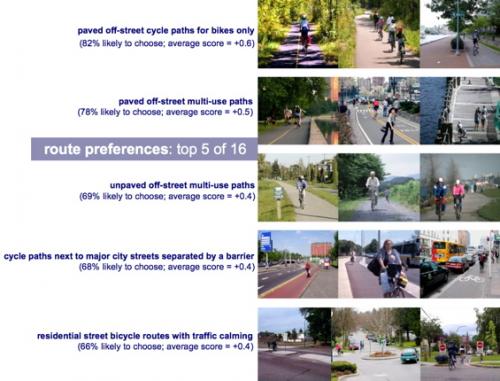Cyclists fare best if they can treat themselves to a road without motor vehicles. This is the message cyclists gave researchers at the University of British Columbia working on a study called Cycling in Cities, led by Professor Kay Teschke.
 Top 5 Preferred Routes
Top 5 Preferred Routes
The multiphase study includes a survey of the public, asking which road and path types they prefer to cycle on, and the road and path type they actually use. The type they use is heavily influenced by what's available in the city. Looking at preferences helps city planners decide how bicycle routes can be designed to attract the most cyclists.
The study ranks routes according to preference. The highest preference was for fully separate paths, like park paths or rail trails. This isn't surprising, but there will always be the problem that not many people live at one end of a park and work at the other. For streets, if the street is a major arterial, people want a physical barrier separating them from the motor traffic. If it's a residential street, people want traffic calming and bike markings.
The researchers classified cyclists based on factors like gender, cycling frequency and parenthood.
Women and people with children scored the low preference routes even lower than men and people without children. This evidence suggests that motivating those who cycle least often requires that the most desirable routes be the focus of development.
Momentum Magazine has more information from the researchers:
Dr. Teschke, a four-year member of the City of Vancouver Bicycle Advisory Committee, initially became interested when she noticed that, as a mother who was uncomfortable cycling in the city with her young daughter, her views on the needs of urban cyclists were different than those of many of the seasoned committee members representing cyclists in the city.
and ...
Research abounds on helmets and cycling, but coming from an occupational health background, Dr. Teschke knows that personal protective gear is one of the least effective ways to prevent injury, because it doesn't prevent an actual crash. The best approach is what is known as an engineering control: separating cyclists and motorized vehicles, eliminating the opportunity for the accident altogether.
This same concept is shown in the design standard used in London, a standard that can be applied to all roads. A well designed road will meet the needs of cyclists by taking into account vehicle speed and traffic volume. This chart says it all (click on it for a better view).
 London's Design Standard
London's Design Standard
What the UBC study and the London rules recognize is that roads with many types of users must be designed with each of them in mind. It is all a matter of design.
Until these routes are built, cyclists will continue to look out for themselves, but cities will need to do their part if cyclist numbers are to increase. Vehicular cycling may be promoted by cities and provinces as the self defense class for the roads, as has been done for decades now, but it is clear from this study that people will not be convinced.
Cyclists in Toronto will be interested to see the results from the next phase of the study: Bicyclist Injuries and the Cycling Environment. This will give numbers regarding injuries compared to types of routes, recorded in Toronto and Vancouver. According to Kay Teschke, Montreal could not be included because of particular difficulties conducting hospital based research there.
Thanks to Veronica for passing this story on to us.



